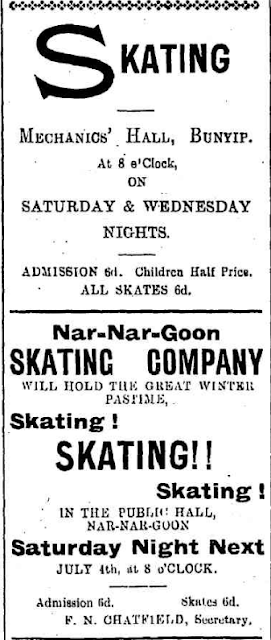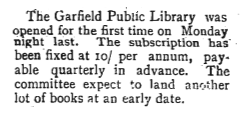The Garfield Mechanics' Institute was opened in March 1889 (1). A mechanics' institute generally housed a public hall and a library with books aimed to improve the education and knowledge of ‘mechanics’ a term used to describe the working man or tradesman.
In the 1890s Mechanics' Institutes had to send in a return to the Government and these returns were published in the annual Statistical Register for the Colony of Victoria compiled from official records in the office of the Government Statist (2). Garfield appears in the 1890, 1891 and 1892 editions of the Statistical Registers. They tell us that the cost of the building was £224 and that it initially had a Library of 100 volumes; in 1891 the number of books had increased to 150, it was open from 7.00pm to 9.00pm on Wednesdays and Saturdays and had 500 visits through the year. In 1892 the Library had decreased to 120, the opening hours were the same and the number of visits was not listed.
The new Garfield Mechanics' Institute was used for a variety of other functions. For instance, in October 1889, it was reported that-
A conversazione was held in the Mechanics' Institute on the 4th inst. The attendance was very large considering the state of the weather. The following ladies and gentlemen took part in the programme provided: Miss Garrett played "Les Cloches du Monasterie" with great taste and execution. Mesdames Skinner, Spence, and Canning, with the Misses Skinner, Canning, and Jefferson, contributed some vocal and instrumental selections. Miss Watson and Master Farrow recited. Mr. Spence did not appear to remember the words of the pretty little ballad he sang, which met with faint applause. Messrs. Carter, Jefferson, and Garrett were encored for the rendition of their comic songs. Mr. Pollock's song, "Happy Moments" and Mr. Murphy's "The Good Rhine Wine" elicited warm approval from the audience. Mr. Edwards, suffering from a severe cold, attempted to sing "Nil Desperandum" but his voice was almost inaudible. Mr. Skinner sang "Doctor Quack" with his usual ability. The three consecutive comic songs of Mr. Hargreaves, completely took the audience by storm, thus proving that the comical element is better appreciated in Garfield than the sentimental. The services of those old favorites, Mr. and Mrs. Skinner, are quite indispensable to Garfield (3).
The Mechanics' Institute very nearly had a short life as in August 1890 the Warragul Guardian noted that -
On Sunday evening last an attempt was made to burn down the Mechanics' Institute, at Garfield. Mr. Ritchie who lives in the neighbourhood noticing a bright reflexion through the window of the hall, and knowing no one should be in there at the time went across to the building. He found the door open and the building on fire, but fortunately was able to extinguish the flames before they had attained any material headway. Immediately after he had successfully achieved this object, he informed Constable Canty of the occurrence, who with a party of trackers started to discover the incendiary. So far we have no information as to the search for the incendiary having been successful (4).
I have no information as to where this first hall was located or what happened to it, but by 1902 there was a movement in the town for a new Hall and a committee was formed to start collecting money and fund raising activities such as balls at Tynong and Iona were held over that year and the next. This is the report of the ball at Tynong in July 1903-
The ball held at Tynong on Friday last was in aid of the Garfield Hall, and turned out to be very successful. It was carried out in a creditable manner, as is usual when this district arranges anything for the benefit of Garfield. The catering was splendid, and reflects great credit on Mr. Bird (Garfield) for the splendid, small goods he supplied, there being full and plenty for all. The committee, which consisted of Messrs. Hogan, Rutledge, R. Hardwick, A Thorne, G Middenway, C Register, J. Gillespie, F. Edis (Sec.); Misses Rutledge, and Middenway, deserve great praise for the way they worked to bring things to a successful issue. The musicians Messrs. F. Elis (violinist) J. Rutledge (melodian) supplied music of a splendid description, and were heartily thanked for their services gratuitously given. Mr. G. Ellis acted as M.C. and carried out his duties in a worthy manner (5).
At a public meeting held on July 4, 1904 it was decided to purchase some land, on the north side of the railway line and opposite the Railway Station, to build the new public hall. The land, next to the School, was purchased from Mr J.M Gillespie for £10.00 and an energetic working committee was appointed to further the movement, which is undoubtedly another step towards the improvement of the township (6). The Secretary of the Committee was John Daly, the school teacher. The rest of the committee were J.J. Lyons, C. Pitt, G. Park, W.J. Walker and G.W. Ellis (7).
Proposed new public hall at Garfield
Bunyip and Garfield Express July 7, 1904, p. 3.
The official opening of the Hall was on Saturday, November 26 1904 with a concert of a high class nature (8). A report of the official opening in the Bunyip and Garfield Express said that the hall was a very commodious building, capable of accommodating between 250 and 300 people. It is constructed of pine walls with hardwood beams and is very tastefully designed. The staging and dressing rooms being up to date, altogether no fault could be found with the structure. ..... The main hall is 45 by 25 feet width, walls 14 feet, with stage fitted up in latest style and built into the foundation. In addition there were two dressing rooms which could be opened to one large room, 25 feet by 10 feet and used for Lodge meetings etc. The hall was designed by J.H. Walker and built by Ingebert Gunnelson (9).
Garfield Public Hall, which opened in 1904
Berwick Pakenham Historical Society photograph (image has been cropped)
There had been an earlier function in the hall when the Garfield Branch of the Australian Natives Association (A.N.A) had held a banquet there on November 18 (10). The A.N.A was a Friendly Society, with the aim of offering financial assistance to its members so thus provided sick pay and funeral benefits. It also aimed to promote the moral, social and intellectual improvement of its members.
The opening ball was held on Wednesday, December 7, which was an unqualified success according to the Bunyip & Garfield Express (11). Other early functions included the Garfield Cricket Club’s concert and ball held on December 30, where dancing was kept up till the early hours of the morn (12). In the August of 1905 a progressive euchre party and dance was held by the Garfield Progressive Association and in the same month the A.N.A organized a public lecture where Senator Findlay spoke about his recent trip to Japan and China (13).
Report of the opening ball at the new Garfield Hall
Bunyip and Garfield Express December 15, 1904, p. 3
A new Garfield Public Library was opened on February 12, 1906. The subscription was 2 shillings and six pence a quarter or 10 shillings per annum (14). A report in the South Bourke & Mornington Journal said the Committee had secured a splendid stock of books (15). It is likely that this Library was located in the Hall, perhaps in one of the dressing rooms.
The opening of the Library
Bunyip and Garfield Express February 15, 1906, p. 2.
The usual range of events were held in the Garfield Hall - dances, dinners, use as a polling booth, concerts, wedding receptions etc. Then on Thursday, April 15 in 1937 the Hall was destroyed by fire. It had apparently started at 1.30am in the supper room and everything was destroyed except for some military equipment in a semi detached room at the back, according to a report in
The Argus. The Hall was insured for £400.00 and its contents for £100.00
(16). It was rebuilt and was re-opened possibly as early as September 22 the same year. Once again the hall hosted a range of social events - in the early 1950s my Dad, Frank Rouse, remembers that square dancing was very popular and that the Hall was packed for those dances - the caller was Bill Colvin of Koo Wee Rup.
Garfield Public Hall, which opened in 1937
Berwick Pakenham Historical Society photograph.
Over 1953 -1954 improvements were made to the Hall and the kitchen, supper room and ladies toilets were updated. In March of 1954 a Civic Ball was held in the Hall to celebrate the visit of the Queen and Prince Phillip to Australia, they had visited Warragul the day before. Naturally the Queen and Prince Phillip were not in attendance but the local M.L.A, Les Cochrane, and the Berwick Shire President and most of the Councillors were present. The Hall had been decorated with flags and bunting and special lighting effects. The ballerina of the ball was Miss Elvie Cameron (17).
The Hall was destroyed by fire, once again, on February 2, 1984 (18).
Trove list - I have created a lost of articles on the Garfield Mechanics' Institute and Public Hall, access it
here.
Footnotes
(1)
The Age, March 9, 1889, see
here.
(2) Statistical Registers - available
here on the Victorian Government Library Service website.
(3)
Great Southern Advocate, October 18, 1889, see
here.
(4)
Warragul Guardian, August 22, 1890, see
here.
(5)
South Bourke & Mornington Journal, July 22, 1903, see
here.
(6)
South Bourke & Mornington Journal, July 20, 1904, see
here.
(7) Bunyip and Garfield Express July 7, 1904, p. 3.
(8) Bunyip and Garfield Express, December 1, 1904, p. 3
(9) Ibid
(10) Bunyip and Garfield Express, November 24, 1904, p. 3
(11) Bunyip and Garfield Express, December 15, 1904, p. 3
(12) Bunyip and Garfield Express, January 5, 1905, p. 3
(13)
South Bourke & Mornington Journal, July 26, 1905, see
here and August 9, 1905, see
here.
(14) Bunyip and Garfield Express February 15, 1906, p. 2.
(15)
South Bourke & Mornington Journal, February 21, 1906, see
here.
(16)
The Argus, April 16, 1937, see
here and
The Age, April 16, 193, see
here.
(17) I clearly got this information from somewhere when I first wrote this blog post in 2014, but now in 2022 when I am updating it, I can't find the source.









crop.jpg)







